Fast Food Business Plan Samples
-
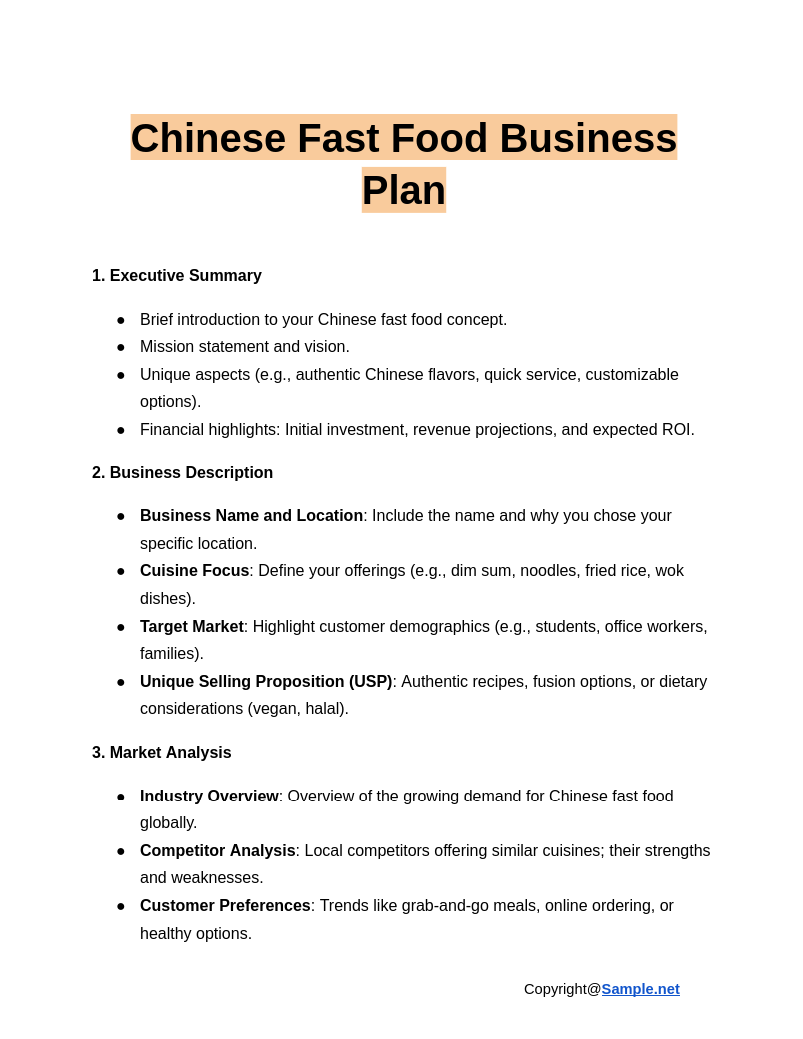
Chinese Fast Food Business Plan
download now -
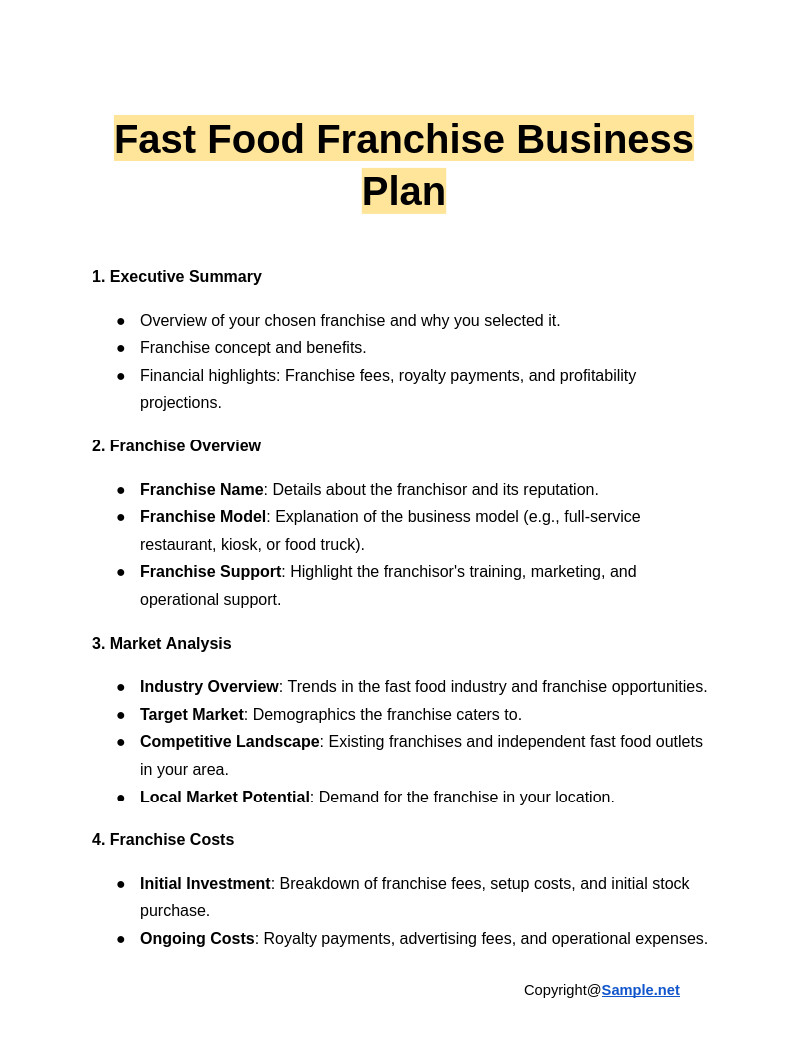
Fast Food Franchise Business Plan
download now -
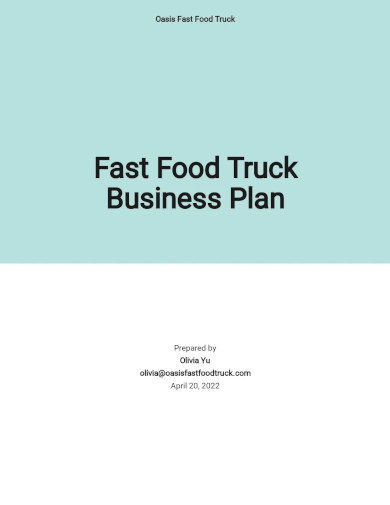
Free Fast Food Truck Business Plan Sample
download now -
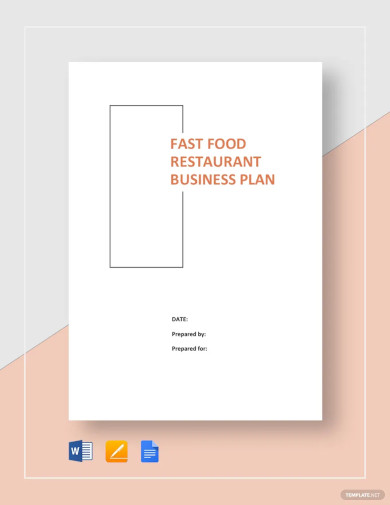
Fast Food Restaurant Business Plan Template
download now -
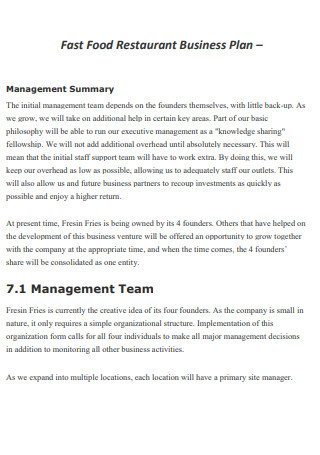
Fast Food Restaurant Business Plan
download now -
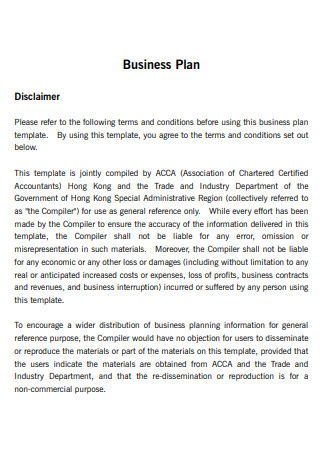
Fast Food Business Plan
download now -
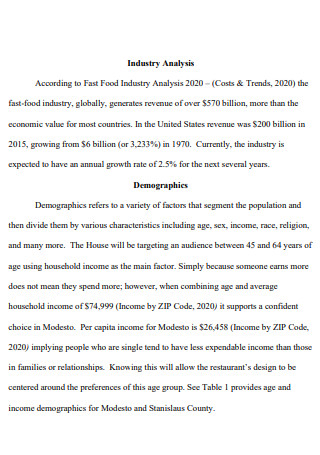
Fast Food Business Plan Analysis
download now -
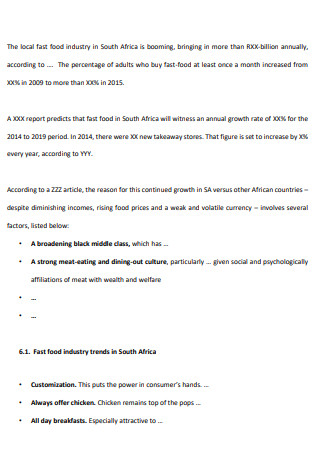
Fast Food Business Plan Example
download now -
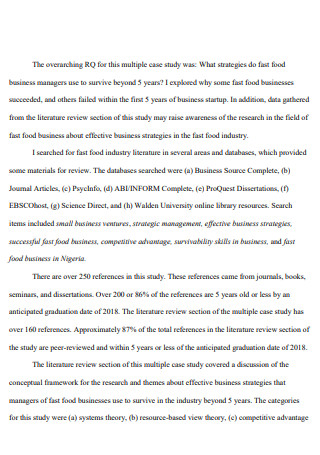
Sample Fast Food Business Plan
download now -
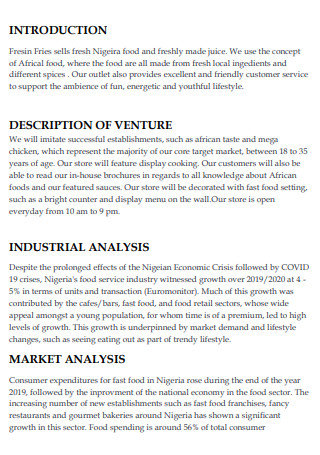
Small Fast Food Business Plan
download now -
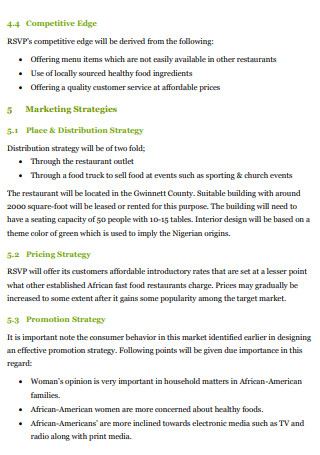
Basic Fast Food Business Plan
download now -
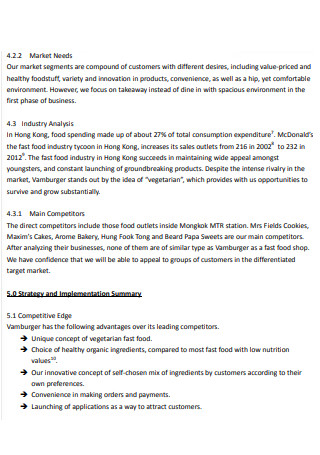
Vegetarian Fast Food Restaurant Business Plan
download now -
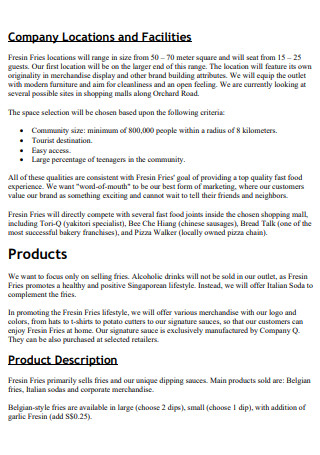
Fast Food Restaurant Sample Business Plan
download now -
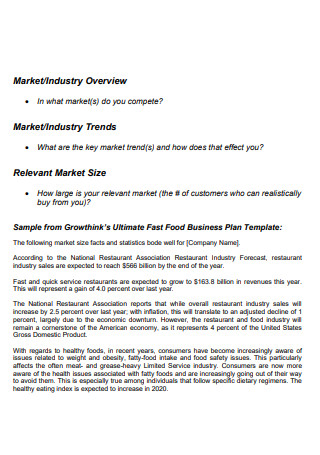
Ultimate Fast Food Business Plan Template
download now -
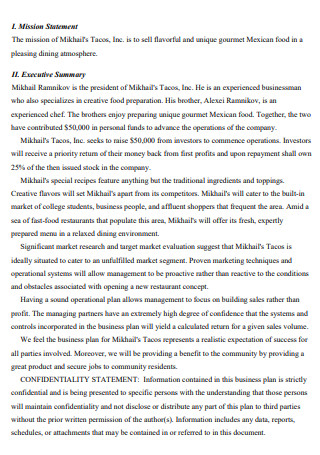
Formal Fast Food Business Plan
download now
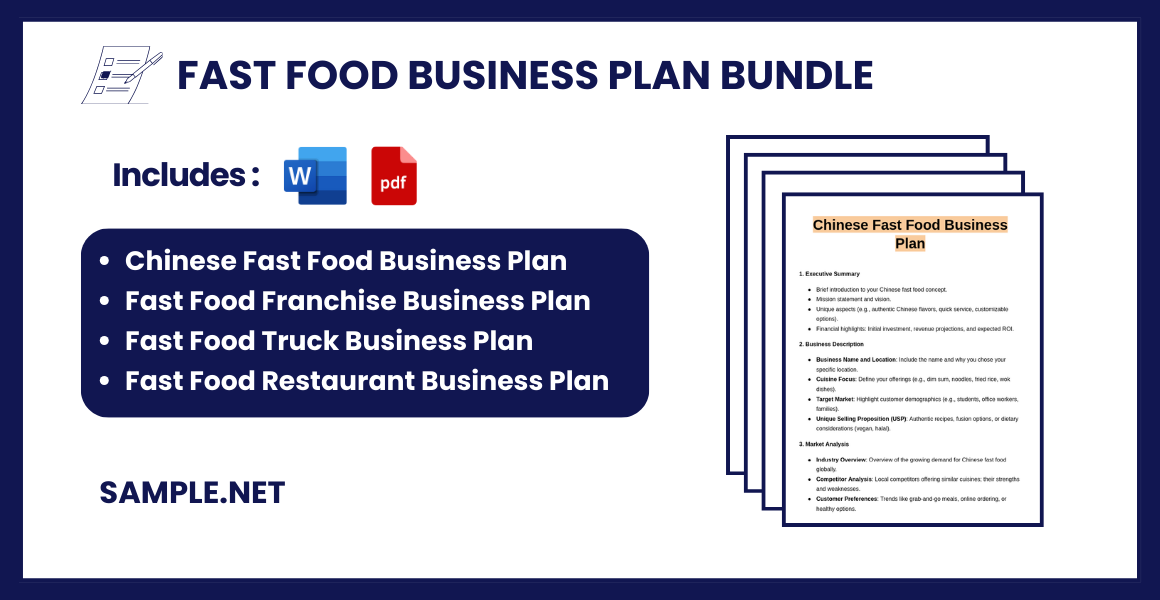
Download Fast Food Business Plan Bundle
Fast Food Business Plan Format
1. Executive Summary
- Brief overview of your fast food business concept.
- Mission statement.
- Objectives (short-term and long-term goals).
- Business highlights (what sets you apart, such as unique menu, location, or theme).
- Summary of financial goals (e.g., initial investment required, expected revenue).
2. Business Description
- Business Name and Location: Name of your fast food business and the location.
- Business Model: Define the model—franchise, independent, food truck, etc.
- Type of Cuisine: Specify the cuisine you will serve (e.g., burgers, pizza, healthy options).
- Target Market: Define your customer demographic (age group, lifestyle, preferences).
- Unique Selling Proposition (USP): Highlight what makes your fast food business different (e.g., affordability, speed, organic ingredients).
3. Market Analysis
- Industry Overview: Brief overview of the fast food industry trends and growth.
- Target Market Analysis: Detailed description of your target customers (e.g., families, college students).
- Competitor Analysis: Identify and analyze key competitors in your area. Highlight their strengths and weaknesses.
- Market Gaps: Explain the gaps your business will fill in the current market.
4. Organization and Management
- Ownership Structure: Define your business structure (sole proprietorship, partnership, LLC, etc.).
- Team Overview: List the key team members and their roles (e.g., manager, chef, marketing).
- Organizational Chart: If applicable, include a diagram of your management structure.
5. Menu and Services
- Menu Offerings: Provide details about your menu items, including any special combos or promotions.
- Pricing Strategy: Outline your pricing strategy (e.g., competitive, value-based).
- Additional Services: Include services like delivery, catering, or loyalty programs.
6. Marketing and Sales Strategy
- Marketing Plan:
- Branding: Logo, colors, and brand identity.
- Advertising: Digital marketing, social media campaigns, local promotions.
- Offline Marketing: Flyers, local sponsorships, grand opening events.
- Sales Channels: Describe how customers can order (walk-in, online, app-based).
- Customer Retention: Discuss loyalty programs, discounts, or special offers.
7. Operations Plan
- Location: Detail your physical location or mobile setup.
- Equipment: List the equipment needed (e.g., fryers, grills, cash registers).
- Suppliers: Identify your suppliers for food, packaging, and other materials.
- Daily Operations: Describe how you will handle ordering, food prep, and customer service.
- Staffing Plan: Number of employees required and their roles.
8. Financial Plan
- Startup Costs: Breakdown of initial investment (equipment, rent, marketing, etc.).
- Revenue Model: How your business will make money (per-item sales, combos, etc.).
- Profit and Loss Statement: Projected income, expenses, and profit for the first year.
- Break-Even Analysis: How long it will take to cover your initial investment.
- Funding Requirements: If applicable, specify how much funding you need and how you will use it.
9. Legal and Licensing
- List all permits and licenses required for your fast food business (e.g., food safety license, health inspections, business registration).
- Compliance with local health and safety regulations.
10. Appendix
- Include supporting documents such as:
- Sample menus.
- Team resumes.
- Equipment cost quotes.
- Market research data.
- Floor plans or truck designs (if applicable).
What is a Fast Food Business Plan?
A Fast Food Business Plan is a comprehensive document that defines the strategies and goals of a fast food business. It includes details about the target audience, menu offerings, location, marketing strategies, and financial projections. This plan serves as a blueprint to ensure smooth operations, profitability, and sustained growth. By laying out every aspect of the business, entrepreneurs can mitigate risks and seize opportunities effectively. You can also see more on Retail Business Plan.
Components of a Fast Food Business Plan
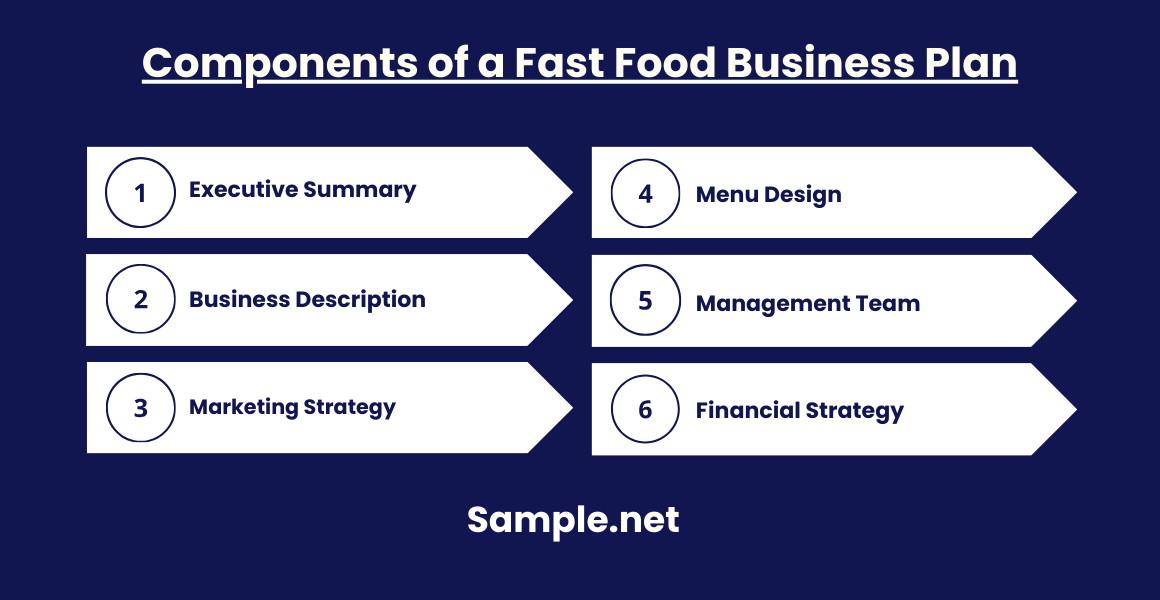
Making a healthy fast food business plan is a must. You must know how to make a fast food plan. You should know how to write a fast-food business plan. Here are the components that you should include in it:
1. Executive Summary
You should start with an executive summary of fast food business plan. This will be a great introduction about your business. You have to give a summary of your idea for your business. The main purpose is to draw the audience to read your whole business plan. This introduction should be compelling and something that can capture the interest of the readers. The elements of an executive summary consists of:
- Mission statement
- Vision statement
- Overall concept
- Possible cost
- Possible ROI (return on investments)
This section is important because investors sometimes look only for the summary to see whether they can have an interest about your business. So, be sure to make a great executive summary for you to have a great ace in your business plan.
2. Business Description
In creating a fast food business plan, you need to introduce your company. Give a detailed description about your business. You have to state the name of your company, where it is located, your contact information, and other relevant data about your business. You should also include some details about you or the owner. Make a short description about your experience. Maybe it could be something that you have experienced when you are starting the business. You can write your challenges or anything that can be interesting for the readers. You should also highlight the legal details of your company. The reader must know that your business is a legal entity. Then, tell the smart Business goals of your company, whether short term or long term goal action plan. You can also include a short market study that shows that you have knowledge about the trends in fast food business.
3. Marketing Strategy
Make a market analysis for the business plan. It will be a good marketing plan of a fast food business that you can use. You should have an industry analysis and competition analysis. The industry analysis will tell your target market. It will tell of the demographics whom your fast food chain will serve. You can explain how investors will choose your business over others. The competition analysis is a research that will be important for the customer base. You have to take note of the prices and menu of other fast food brands. This will let the investors know of your difference from other fast food business. You can also discuss the economic conditions that can affect your business. Tell how you can be apart from your competitors. Also, make this a publicity section on how you can market your fast food business.
4. Menu Design
The most important section is the menu. The fast food restaurant relies heavily on this. Especially since the fast food chains have food budget meals that should be represented in the best way in the menu. Menu matters a lot because it contains your main product. It is needed before you can serve your food. Make a mock-up for the menu. Add a logo and make a good design for it. Doing it will attract more customers and the investors can have a better consideration of your products. You can hire a designer if you want to have the best menu. In making the menu, you have to consider the most important thing which is pricing. Be sure that the price of your foods are relatively fair. It should justify the cost analysis and should be something that can attract customers.
5. Management Team
You should make a description about your management and your employees. Tell the investors about your employees that are already on board. Do not forget your key workers that have special work expertise. It will be good that you will introduce them to show that your business has a good team.
6. Financial Strategy
Another important part is the financial section. You can ask the help of a professional in doing a financial analysis. Accountants can help you to have financial estimates for your insight for your fast food business. Give the details about your fast food business so the accountant will know how to advise you for your business. You can get financial strategies that can help you to set financial goals for your business.
How to Create a Fast Food Business Plan
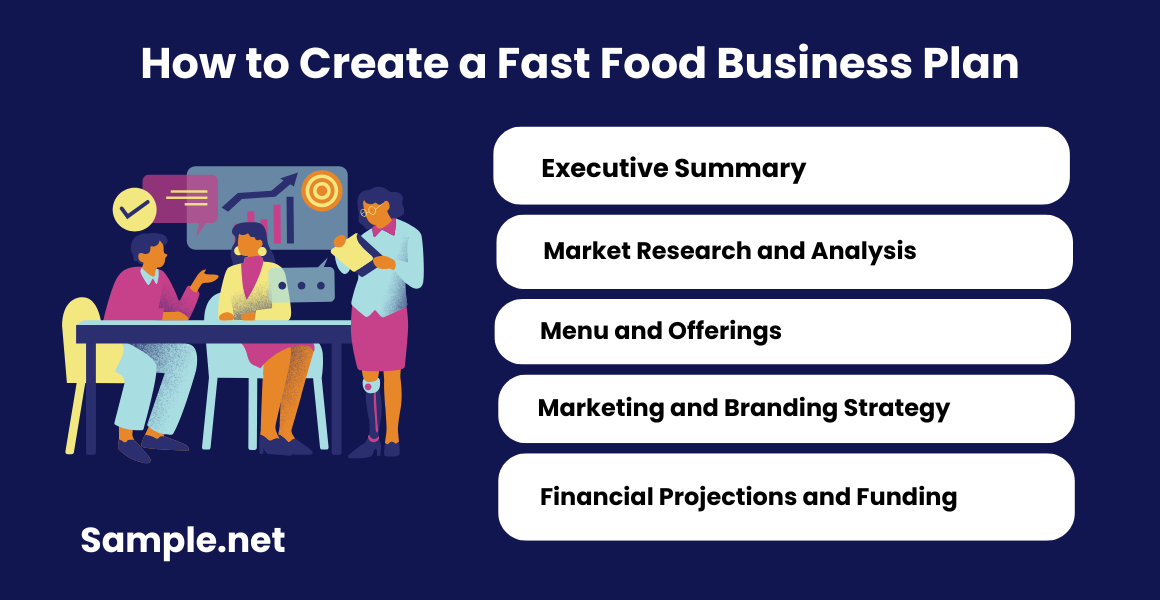
1. Executive Summary
Begin with a concise summary of your business concept, target market, and goals. Highlight what makes your fast food business unique, such as innovative menus or a focus on quality. Include an overview of your funding requirements and expected returns to attract potential investors.
2. Market Research and Analysis
Conduct thorough research to understand your target market’s preferences, demographics, and buying behavior. Analyze competitors to identify gaps your business can fill. Include data on fast food industry trends to demonstrate growth potential. Detailed research builds a solid foundation for a competitive strategy.
3. Menu and Offerings
Develop a menu that aligns with your target audience’s preferences. Highlight signature dishes or unique items that set your business apart. Include options for various dietary needs, such as vegetarian or gluten-free. A well-planned menu appeals to diverse customers and boosts brand loyalty. You can also see more on Investment Company Business Plan.
4. Marketing and Branding Strategy
Outline your marketing approach, including social media campaigns, promotions, and collaborations. Define your brand identity, such as logos, slogans, and overall vibe. Focus on customer engagement strategies to build a loyal customer base. Effective marketing drives traffic and establishes your brand.
5. Financial Projections and Funding
Include detailed financial plans, such as startup costs, operational expenses, and revenue projections. Identify funding sources, such as loans, investors, or personal savings. Provide realistic profitability timelines and break-even points to reassure stakeholders. Strong financial planning ensures sustainability and growth.
FAQs
How do I choose the right location for a fast food business?
Location is crucial for a fast food business as it directly impacts foot traffic and visibility. Consider areas with high pedestrian or vehicle traffic, proximity to offices, schools, or shopping centers, and availability of parking. Research demographic data to ensure the location aligns with your target market. Additionally, evaluate competition and rent affordability to strike a balance between visibility and cost-effectiveness.
What should be included in the financial section of the business plan?
The financial section should include startup costs, operational expenses, pricing strategy, revenue projections, and break-even analysis. It must also outline funding sources such as loans or investors and include a cash flow statement. Detailed financial planning provides a clear picture of profitability and assures investors of the business’s viability.
What are the common risks in starting a fast food business?
Common risks include stiff competition, fluctuating food costs, regulatory compliance, and staffing challenges. Supply chain disruptions or economic downturns can also impact operations. Mitigating these risks requires careful planning, regular monitoring, and contingency measures such as diversifying suppliers or adjusting pricing strategies. Proactive risk management ensures business continuity. You can also see more on 5 Year Business Plan.
What role does branding play in a fast food business?
Branding shapes customer perception and sets your business apart from competitors. A strong brand identity, including a catchy name, logo, and consistent messaging, builds recognition and trust. Branding also influences customer loyalty, as people tend to associate memorable brands with quality and reliability. Invest in professional branding to establish a distinct market presence.
How do I ensure my fast food business remains profitable?
Profitability hinges on managing costs, optimizing pricing, and maximizing customer retention. Regularly analyze expenses and negotiate with suppliers for better deals. Implement strategies like upselling and bundling to increase average order value. Additionally, focus on customer satisfaction and repeat business through loyalty programs or personalized offers. Continuous monitoring of financial performance ensures profitability. You can also see more on Executive Business Plan.
